POULTRY
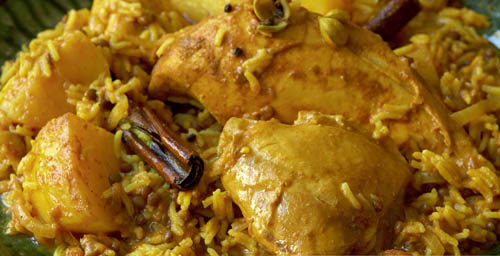
FRIED CHICKEN BREAST WITH MUSHROOM-SHERRY SAUCE
Do remember that unless you have to remove the skin for health reasons, chicken breasts with the skin intact are more flavoursome. The delicious mushroom and sherry sauce will combat any hint of dryness in the breast meat.
- 6 chicken breasts with skin on
- sea salt and pepper
- 1 Tbsp butter
- 2 Tbsp olive oil
- SAUCE
- 2 Tbsp butter
- 2 Tbsp olive oil
- 300 g white mushrooms, sliced
- 3 cloves garlic, crushed
- 350 ml fresh cream
- 150 ml medium sherry
- salt and pepper
- Cut 4 slits into the skin of each chicken breast and season with the sea salt and pepper. In a large frying pan, heat the butter and oil and brown the chicken breasts for 5 minutes on each side.
- Keep warm.
- For the sauce, melt the butter and oil in a saucepan, add the mushrooms and garlic, and stir for 3 minutes. Add the cream, sherry, and salt and pepper, then simmer for 10 minutes. Transfer the chicken pieces to a serving dish and pour the sauce over. Serve with North African Couscous Salad (see page 134) and Roasted Vegetable Salad (see page 25). SERVES 4–6
CHICKEN JOLOF
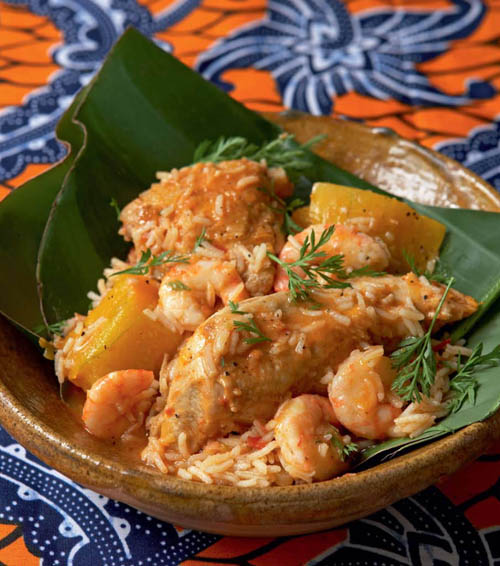
This colourful dish hails from West Africa and is often served on special occasions. Best of all, it is a complete meal in one pot.
- 2 kg chicken pieces
- salt and pepper
- 3 Tbsp vegetable oil
- 3 leeks, sliced
- 2 cloves garlic, crushed
- 1 fresh green chilli, finely chopped
- 400 g tomatoes, peeled and chopped
- ½ cup white wine
- 2½ cups chicken stock
- 1 cup uncooked basmati rice
- 1 cup cubed butternut
- 200 g fresh shrimps, peeled and deveined
- grated rind of 1 lemon
- 1 Tbsp chopped fresh parsley
- Season the chicken with salt and pepper.
- Heat the oil in a frying pan and brown the chicken. Transfer the fried chicken pieces to a large pot and set aside. Pour off the excess oil, leaving about 3 tablespoons in the pan. In the same frying pan, sauté the leeks and garlic until just soft, then add the chilli, tomatoes and wine. Simmer for 10 minutes, then stir in the chicken stock and pour all into the pot with the browned chicken. Simmer for a further 10 minutes. Add the rice, stirring gently, then lower the heat, cover and leave to cook for 5 minutes. Add the butternut and after 5–7 minutes, stir in the shrimps. Season with salt and pepper. Just before serving stir in the lemon rind and parsley. SERVES 4–6
NORTH AFRICAN CHICKEN TAGINE
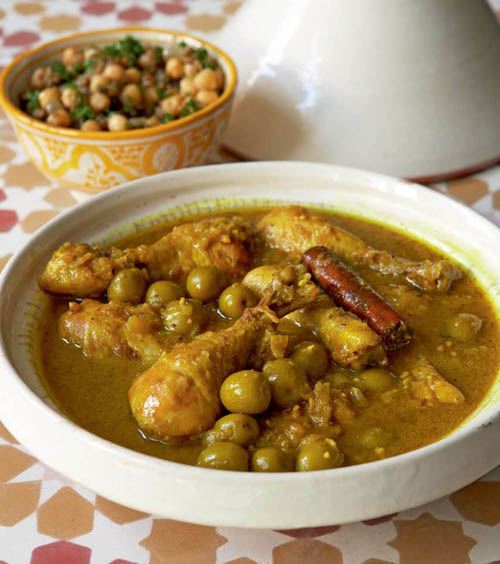
Tagines are semi-glazed earthenware dishes with pointed, conical lids, particularly used in Moroccan cooking. If you don’t have one, use an ovenproof casserole dish instead. Olives are highly characteristic of North African-Mediterranean cuisine.
- 4 Tbsp vegetable oil
- 8 chicken drumsticks
- 2 onions, finely chopped
- 3 cloves garlic, crushed
- 1 tsp ground ginger
- 1 tsp turmeric
- 1 stick cinnamon
- 2 cups chicken stock
- 1 cup pitted green olives
- salt and pepper
- In a frying pan, heat the oil and brown the chicken pieces, then transfer them to a large pot.
- Pour off some of the oil from the frying pan, leaving about 2 tablespoons. Fry the onions in the oil until soft, then add the garlic, ginger, turmeric and cinnamon, and stir-fry for 2 minutes.
- Pour in the chicken stock and bring to the boil.
- Add the onion mixture to the pot of chicken, followed by the olives. Season with the salt and pepper and simmer for 40 minutes.
- Serve with couscous and Chickpea and Lentil Salad (see page 140). SERVES 4–6
CHICKEN IN GROUND CASHEW NUT SAUCE
Although native to South America, the cashew nut tree was introduced to Africa by Portuguese traders and now these trees grow prolifically in Nigeria, Mozambique, Tanzania and Kenya. The nuts add both nutrition and flavour to this dish.
- 4 Tbsp olive oil
- 3 onions, chopped
- 1 × 410 g can peeled tomatoes
- 1 Tbsp tomato paste
- ¼ tsp chilli powder
- ½ tsp turmeric
- 1 clove garlic
- 2 Tbsp chopped fresh coriander
- 1 cup chicken stock
- 70 g cashew nuts
- 6 chicken breasts, cubed
- salt and pepper
- 1 Tbsp plain yoghurt
- Heat the oil in a pot and sauté the onions for 3 minutes. Add the tomatoes, tomato paste, chilli powder, turmeric, garlic, coriander and chicken stock, then blend in a food processor until smooth.
- Return to the pot.
- Pound the nuts in a mortar until they are a fine powder and then add to the sauce. Simmer gently for 10 minutes. Add the chicken breasts and simmer for another 10 minutes. Season with the salt and pepper. Just before serving stir in the yoghurt.
- Serve with rice. SERVES 4–6
CHICKEN WITH PORT AND RAISINS
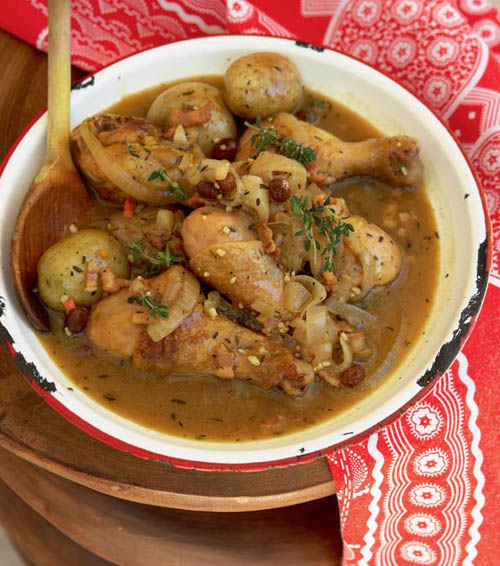
In Namibia a tradition has developed in which this dish is served for romantic dinners. The port and raisins impart an intriguing sweetish flavour to the chicken.
- ¼ cup vegetable oil
- 12 chicken drumsticks
- 80 g streaky bacon, diced
- 2 onions, sliced into rings
- 3 cloves garlic, crushed
- 1 tsp dried thyme
- 1 cup port
- 3 cups chicken stock
- ½ cup raisins
- salt and pepper
- 10 baby potatoes
- Heat the oil in a deep frying pan and brown the chicken for about 10 minutes. Remove from the frying pan and set aside.
- In the same pan, add the bacon and brown lightly. Add the onions and garlic and sauté until the onions are soft. Stir in the thyme and pour in the port, then boil for 2 minutes. Add the chicken stock and raisins. Place the chicken back into the frying pan and season with the salt and pepper. Simmer, covered, for 20 minutes.
- In the meanwhile, boil the baby potatoes in salted water for approximately 7 minutes, or until soft.
- Serve the chicken with the boiled potatoes. SERVES 4–6
MOROCCAN LEMON CHICKEN WITH OLIVES
This traditional dish makes for a quick and easy meal.
- 4 Tbsp olive oil
- 2 Tbsp butter
- 2 kg chicken, cut into pieces (or 12 chicken thighs)
- 3 onions, finely chopped
- 2 cloves garlic, crushed
- 400 g tomatoes, chopped
- ¼ tsp dried thyme
- 1 tsp dried rosemary
- 1 bay leaf
- 20 pitted green olives
- ¼ cup lemon juice
- salt and pepper
- 2 cups fresh cream
- In a frying pan, heat the oil and butter and brown the chicken pieces, then transfer them to a large pot.
- In the same frying pan, reduce the heat and sauté the onions and garlic until soft. Add the tomatoes and sauté them for approximately 7 minutes until soft. Stir in the thyme, rosemary and bay leaf and bring all to the boil.
- Add the tomato and herb mixture to the chicken pot, along with the olives, and simmer, covered, for 25 minutes. Stir in the lemon juice and season with the salt and pepper. Just before serving, stir in the cream.
- Serve with Savoury rice (see page 133). SERVES 4–6
EAST AFRICAN POT ROAST CHICKEN WITH COCONUT CREAM
It’s the combination of coconut cream and chilli that adds oomph to this dish.
- 2 Tbsp vegetable oil
- 2 Tbsp butter
- 1 whole chicken, washed and dried
- ½ onion, roughly chopped
- 3 cloves garlic, crushed
- 1 fresh green chilli, chopped
- 1 cup chicken stock
- 1 × 400 g can coconut cream
- salt and pepper
- Heat the oil and butter in a frying pan and brown the chicken all over. Transfer to a large pot.
- In the same frying pan, sauté the onion, garlic and chilli for 5 minutes. Pour in the chicken stock and coconut cream, and bring to the boil. Season with the salt and pepper. Pour the sauce into the pot with the chicken and simmer, covered, for 1 hour.
- Serve with Coconut rice (see page 136). SERVES 4–6
MALAWIAN SPICED CHICKEN CURRY
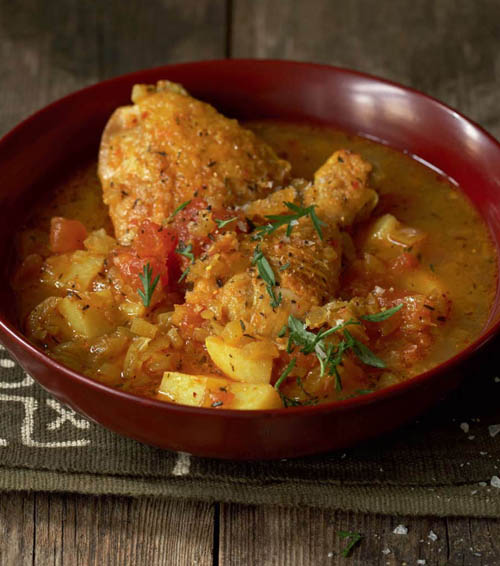
In Malawi this dish is known as nkhuku ya sabola, which means ‘a spicy one’. It is simple to prepare and a favourite for special occasions.
- 500 g chicken pieces, with skin on
- salt
- 3–5 Tbsp vegetable oil
- 3 large onions, chopped
- 5 tomatoes, peeled and chopped
- 2 Tbsp curry powder
- 1 fresh green chilli, chopped
- 1 tsp dried thyme
- 1 cup water
- 2 cups chicken stock
- 1 cup peeled and cubed potatoes
- pepper
- Season the chicken pieces with the salt. Heat the oil in a frying pan and fry the pieces until brown, then transfer to a large pot.
- Pour off most of the oil in the pan, leaving about 2 tablespoons. Sauté the onions until soft. Add the tomatoes, curry powder, chilli and thyme. After a few minutes, pour in the water and stock and bring to the boil. Add the onion mixture to the pot with the chicken. Simmer, covered, for 45 minutes over a very low heat.
- Add the potatoes and cook for a further 15 minutes. Season to taste with salt and pepper.
- Serve with mealiepap (see page 141) or rice, and Malawi’s Favourite Cabbage Salad (see page 135). SERVES 4–6
CHICKEN, MUSHROOM AND LEEK PIE
This pie is ideal as a light lunch.
- 1 × 400 g packet puff pastry
- 2 Tbsp vegetable oil
- 1 onion, finely chopped
- 4 leeks, sliced
- 1 cup quartered button mushrooms
- 6 chicken breasts, cooked and cubed
- salt and pepper
- SAUCE
- 50 g butter
- 50 g cake flour
- ¼ cup white wine
- ½ cup chicken stock
- ½ cup fresh cream
- 1 tsp Dijon mustard
- salt and pepper
- Preheat the oven to 200 °C and spray a pie dish with cooking spray. Roll the pastry out, cut it in half and line the dish with one one half, ensuring that it reaches to the top of the dish.
- Heat the oil and sauté the onion and leeks until soft. Add the mushrooms and stir-fry for 3 minutes, then add the chicken.
- Season with the salt and pepper and set aside.
- To make the sauce, heat the butter in a saucepan, then add the flour. Keep stirring until it starts to brown. Pour in the wine and chicken stock and stir until smooth. Add the cream and mustard and keep stirring until well mixed. Season with salt and pepper and cook for 2 minutes. Combine the sauce and chicken mixture, leave to cool then spoon into the pastry case. Cover with the remaining sheet of pastry and pinch the pastry edges together firmly between your fingers. Cut a small vent into the top of the pie to allow steam to escape. Bake for 30 minutes.
- Serve with a salad of your choice. SERVES 4–6
SHEBEEN CHICKEN
Originally a shebeen was an illicit bar in Ireland where unlicenced alcohol was sold. The popularity of shebeens spread to other countries, including South Africa, where many shebeens are now legal. The atmosphere is congenial and lively and this definitely influences the food that is served, washed down with local beer.
- 6 chicken breasts, skinned and deboned
- 1–2 tsp chicken spice
- 6 spinach leaves
- 1 cup chopped dried apricots, soaked in boiling water for 1 hour
- 1 onion, chopped and lightly sautéed
- 1 litre chicken stock
- SAUCE
- 2 Tbsp butter
- 1 tsp cumin seeds
- 1 Tbsp minced fresh ginger
- 1 cup chicken stock
- 1 stick cinnamon
- 1 bay leaf
- 2 Tbsp lemon juice
- 2 Tbsp coriander leaves
- Flatten the chicken breasts with a rolling pin and rub in the spice.
- Top each breast with a spinach leaf and spread with apricots and sautéed onion. Roll each into a sausage shape and wrap each in clingwrap, sealing at both ends with a knot. Bring the 1 litre chicken stock to the boil and poach the breasts for 15 minutes.
- Make the sauce in the meanwhile by melting the butter in a pan, stir in the cumin seeds and ginger and cook for 1 minute. Add the cup of chicken stock, cinnamon, bay leaf and lemon juice and simmer for 10 minutes. Remove the cinnamon stick and stir in the coriander leaves. Remove the chicken from the clingwrap and arrange in a serving dish. Pour the sauce over and serve with North African Couscous Salad (see page 134). SERVES 4–6
AFRICAN POT ROAST CHICKEN WITH VEGETABLES
This could almost be an Irish stew, but it is given an African touch with the addition of unripe bananas!
- 2 Tbsp vegetable oil
- 1 whole chicken
- 2 cups chicken stock
- 1 tsp dried thyme
- 1 tsp turmeric
- 2 lemon leaves
- 1 × 410 g can peeled tomatoes
- 4 carrots, peeled and sliced
- 2 unripe bananas, peeled and sliced
- 2 cups shredded cabbage
- 1 potato, peeled and diced
- salt and pepper
- In a large pot, heat the oil and brown the chicken. Pour in the chicken stock, then add the thyme, turmeric, lemon leaves and tomatoes. Cover and simmer for 30 minutes, then add the rest of the vegetables. Simmer for a further 10 minutes.
- Season with the salt and pepper.
- Serve with rice. SERVES 4–6
TURKEY DRUMSTICKS WITH SHERRY-LIVER SAUCE
Turkeys are reared in many parts of Africa, but not always for the pot as they are regarded as domestic pets in some countries. Only when people have run out of food will they resort to turkey meat, or for the most special of occasions.
- 3 turkey drumsticks
- salt and pepper
- 12 rashers streaky bacon
- olive oil
- SAUCE
- 50 g butter
- 1 onion, chopped
- 3 cloves garlic
- 2 cups chicken stock
- 2 Tbsp vegetable oil
- 250 g chicken livers
- 1 tsp dried thyme
- 150 ml medium sherry
- 100 ml cream
- Preheat the oven to 180 °C. Season the turkey with the salt and pepper, then wrap about 4 bacon rashers around each drumstick. Place the drumsticks in a roasting dish and drizzle with the olive oil. Roast for approximately 1 hour.
- For the sauce, melt the butter in a saucepan, then sauté the onion and garlic until soft. Pour in the chicken stock and simmer for 10 minutes.
- In a frying pan, heat the oil until hot and fry the chicken livers until just light brown. Add the thyme and the sherry and cook for 5 minutes. Pour in the onion, garlic and stock mixture and boil for 3 minutes. Stir in the cream, leave to cool and then blend until smooth. Reheat the sauce and serve with the turkey drumsticks and Chickpea and Lentil Salad (see page 140). SERVES 4–6
CHICKEN THIGHS AND SPINACH IN PEANUT SAUCE
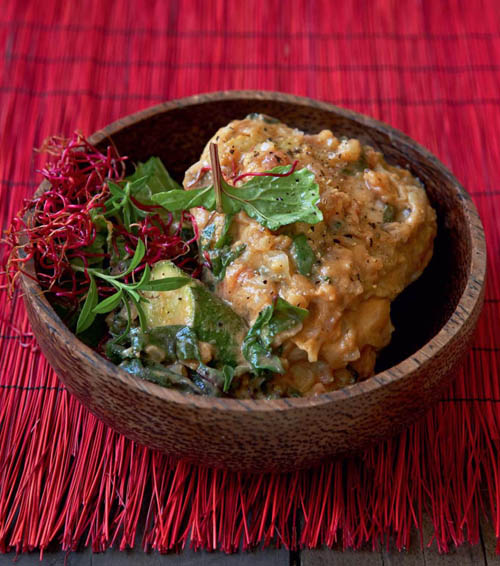
In Zimbabwe this dish is called dovi, which is the word for peanut sauce in that country. It is served with mealiepap, also called sadza. If you don’t already know, baby marrows are also known as courgettes or zucchini.
- 6 chicken thighs
- 4 Tbsp vegetable oil
- 3 onions, finely chopped
- 4 tomatoes, peeled and chopped
- ½ cup chicken stock
- 3 baby marrows, sliced ±1 cm thick
- ¼ cup peanut butter
- ½ tsp cayenne pepper
- 500 g shredded fresh spinach
- salt
- Cut an ‘X’ into the skin of each chicken thigh. Heat the oil in a frying pan and fry the chicken until well browned. Transfer the thighs to a pot and pour off most of the oil from the frying pan, leaving about 3 tablespoons.
- In the same pan, sauté the onions over a low heat until soft, then add the tomatoes and stir until soft. Stir in the chicken stock, then pour this stock mixture into the pot with the chicken and simmer for 15 minutes. Add the baby marrows and peanut butter and stir until the peanut butter has dissolved. Add the cayenne pepper and spinach, and simmer for approximately 5 minutes until the spinach has wilted. Add salt to taste.
- Serve with mealiepap. SERVES 4–6
CHICKEN AND PRAWN CURRY
This is a popular East African dish known as Kuku Nanazi. Kuku means ‘chicken’ and nanazi means ‘pineapple’ in Swahili and Chichewa – one of the languages of Malawi.
- 4 Tbsp olive oil
- 2 onions, finely chopped
- 4 cloves garlic
- 1 tsp ground ginger
- 2 Tbsp curry powder (medium or hot)
- 6 cardamom seeds
- 1 tsp turmeric
- 1–2 fresh green chillies, finely chopped
- 1 × 400 ml can coconut cream
- 5–6 skinless chicken breasts, cubed
- 12 large prawns, shelled and deveined
- 1 small pineapple, peeled and cubed
- salt and pepper
- In a large pot, heat the oil and sauté the onions and garlic until soft. Add the ginger, curry powder, cardamom seeds, turmeric and chillies and fry for 3 minutes. Pour in the coconut cream and add the chicken. Simmer gently until the chicken is almost cooked (10–15 minutes), then add the prawns and continue simmering until they are done. Season with the salt and pepper.
- Serve with rice. SERVES 4–6
CHICKEN BREYANI
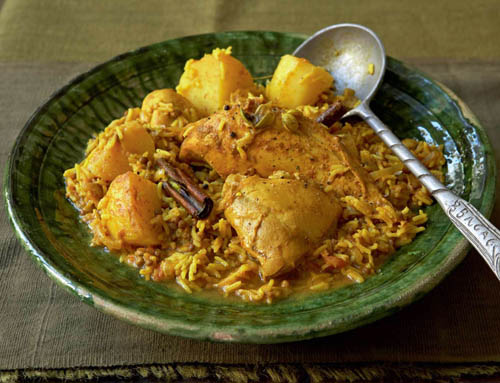
Breyani found its way to Africa via the Indian and Pakistani settlers to the continent. Due to its lengthy preparation, this dish is often served during Ramadan or on special occasions.
- 1.5 kg skinless chicken pieces
- 1 cup brown lentils
- 2 cups uncooked white rice (preferably basmati)
- 1 tsp turmeric
- 2 sticks cinnamon
- 4 cardamom pods
- 1 cup hot water
- 2 onions, sliced
- 4 potatoes, peeled and quartered
- 1 cup chicken stock
- MARINADE
- 1 cup buttermilk
- 2 Tbsp vegetable oil
- 2 Tbsp masala
- 1 Tbsp turmeric
- 1 tsp ground cinnamon
- 1 Tbsp each ground coriander and ground cumin
- 3 fresh green chillies, chopped
- 1 Tbsp grated fresh ginger
- 1½ tsp salt
- 400 g fresh tomatoes, peeled
- Mix all the marinade ingredients together and pour over the chicken pieces until completely covered. Marinate for 2 hours.
- Boil the lentils in water until tender, then drain. Boil the rice in water with the turmeric, cinnamon and cardamom until cooked.
- Transfer the chicken and marinade to a large pot. Bring to the boil and simmer, covered, for 20 minutes. Uncover and simmer for another 10 minutes. Add the rice, lentils, onions, potatoes and stock. Simmer for 20 minutes and serve. SERVES 6–8
OSTRICH SKEWERS BASTED WITH J’S SPICED FRUIT CHUTNEY
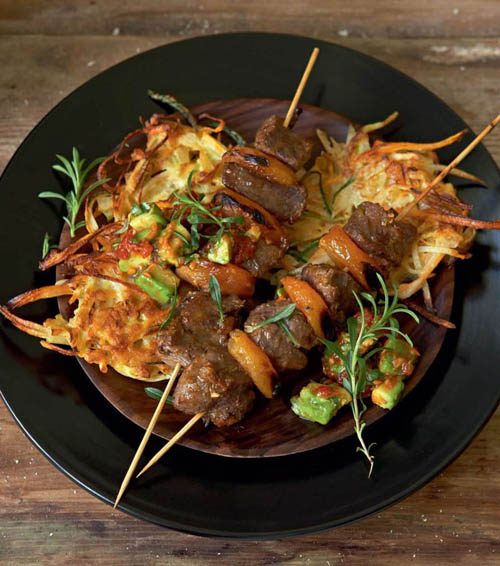
Ostrich meat has a lower fat content than other red meat and is, therefore, healthier and a good choice for those with high cholesterol. Remember to soak bamboo skewers in water for 30 minutes to stop them from burning at either end, or cover them with cooking foil.
- 600 g ostrich steaks
- ½ cup J’s Spiced Fruit Chutney (see page 154)
- 1 fresh green chilli, finely chopped
- 1 Tbsp beef stock powder
- 2 Tbsp red wine vinegar or 2 Tbsp lemon juice
- salt and pepper
- 1 cup soft-eating dried apricots
- 6 bamboo skewers
- Prepare an open fire with coals suitable for braaing (barbecuing).
- Cut the steaks into large cubes. Combine J’s Spiced Fruit Chutney, the chilli, beef stock powder, vinegar or lemon juice, and salt and pepper. Pour this mixture over the ostrich cubes and marinate for a minimum of 30 minutes. Thread the meat and apricots alternately onto the skewers and braai over hot coals, 5 minutes on each side, basting regularly with the marinade.
- Serve with Vegetable Fritters with Avocado and tomato Salsa (see page 121). SERVES 4–6
OSTRICH STEAKS WITH SHIITAKE MUSHROOM-TARRAGON SAUCE
The combination of ostrich meat and shiitake mushrooms creates another exotic Afro-Japanese fusion dish.
- 5–6 ostrich steaks
- 2 Tbsp butter
- 6 spring onions, sliced
- 4 cloves garlic, crushed
- juice of 1 lemon
- 150 g fresh shiitake mushrooms, sliced
- 1 cup fresh cream
- 3 Tbsp chopped fresh tarragon
- salt and pepper
- 4 Tbsp butter
- Pat dry the ostrich steaks.
- In a saucepan, melt the 2 tablespoons of butter and sauté the spring onions and garlic for 5 minutes, or until soft. Add the lemon juice and mushrooms and cook for 3 minutes. Pour in the cream and simmer very gently for 7 minutes, then add the tarragon and season to taste. Keep the sauce warm.
- Season the steaks with pepper and pan-fry in the 4 tablespoons of butter, 4–5 minutes on each side.
- Serve with the mushroom-tarragon sauce and boiled potatoes. SERVES 4–6
OSTRICH STEAKS WITH CHILLI SAUCE AND FIGS
Although ostriches are often associated with South Africa, they were actually introduced by farmers to the south-western part of the country. Before they were hunted out during the nineteenth century, these impressive birds were indigenous in many parts of the continent. Today they still range freely on the plains of East Africa and a few are to be found in south-eastern Egypt.
- 6 ostrich steaks
- black pepper
- 3 Tbsp butter
- 2 medium onions, chopped
- 2 cloves garlic, crushed
- 2 fresh green chillies, chopped
- 2 tsp crushed black peppercorns
- 100 ml red wine
- 200 ml fresh cream
- 8 tsp fig jam
- salt
- 6 fresh figs, quartered lengthways
- Season the steaks with black pepper. Heat the butter in a frying pan and fry the steaks for 4 minutes on each side, then remove from the pan, but keep warm.
- In the same frying pan, sauté the onions, garlic, chillies and peppercorns over a low heat for 5 minutes. Add the wine, cream and jam and boil for 2 minutes. Season with salt.
- Arrange the steaks on a serving dish, pour the sauce over and garnish with the figs.
- Serve with North African Couscous Salad (see page 134). SERVES 4–6
GRILLED OSTRICH STEAKS WITH GOOSEBERRY SAUCE
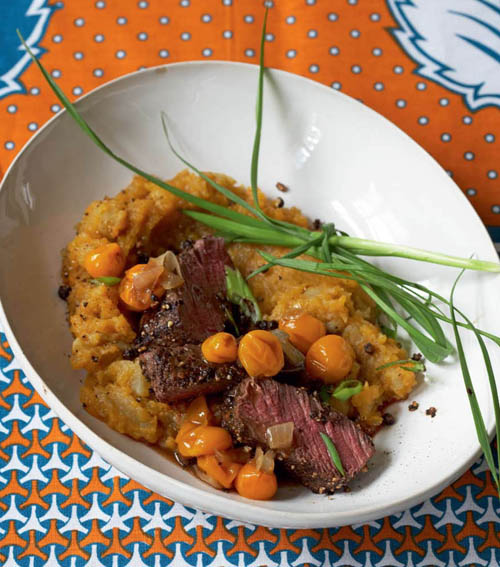
Because gooseberries are easy to cultivate they are a popular choice for jams and sauces in African cuisine.
- 4–6 ostrich steaks
- 2 Tbsp crushed black peppercorns
- vegetable oil for grilling
- SAUCE
- 50 g butter
- 1 onion, chopped
- 1 Tbsp cake flour
- ½ cup white wine
- 1 cup chicken stock
- ½ cup balsamic vinegar
- 1½ cups gooseberries
- salt and pepper
- Pat the steaks dry and rub the crushed peppercorns into them.
- Heat a cast-iron griller, brush the steaks with vegetable oil and grill for 4 minutes on each side. Keep warm.
- Heat the butter in a saucepan and sauté the onion until soft. Stir in the flour until it starts to brown. Pour in the white wine, stirring all the time, then add the chicken stock and simmer for a few minutes. Stir in the vinegar and gooseberries and season with salt and pepper.
- Arrange the ostrich steaks on a serving dish, pour over the sauce and serve with Sweet Potato and Butternut Mash (see page 150). SERVES 4–6
ROAST GUINEA FOWL
Guinea fowl are prolific throughout Africa and their culinary use can be traced back to the diet of the ancient Egyptians. Because the birds breed in such great numbers, they present a ready supply of food.
- 3 Tbsp vegetable oil
- 6 guinea fowl breasts, with wings on
- ½ cup white wine
- 2 cups cream
- 2 large sprigs rosemary
- salt and pepper
- ½ cup toasted cashew nuts
- Preheat the oven to 200 °C. Heat the oil in a frying pan, then sear the breasts for 2 minutes on each side. Remove the breasts from the pan and cut off the wings. Discard most of the fat from the pan, but leave about 1 tablespoon, then deglaze with the wine and cream. Add the rosemary, salt and pepper and reduce the heat. Simmer until slightly thick.
- Put the breasts and wings into a medium-sized roasting pan, pour over the deglazed sauce and bake, uncovered, for 20 minutes.
- Serve with mashed potatoes and blanched spinach. Arrange the spinach on a serving dish, slice the guinea fowl and place the slices on top of the spinach. Place the wings on top of the breasts, spoon the sauce over and sprinkle with the cashew nuts. SERVES 4–6
BRAISED DUCK WITH ORANGE AND LIME SAUCE
Van der Hum® is a South African tangerine-based liqueur. This is duck and orange sauce with a twist!
- 2 kg duck, cut into portions
- salt and pepper
- 3 Tbsp cake flour
- 4 Tbsp olive oil
- 50 ml chicken stock
- 100 ml Van der Hum® liqueur or medium sherry
- 1 cup orange juice
- 150 ml lime or lemon juice
- chopped fresh parsley to garnish
- Preheat the oven to 180 °C.
- Season the duck with the salt and pepper and dust with the flour.
- Heat the oil in a frying pan and brown the duck portions. Pour in the stock, liqueur or sherry, orange juice and lime or lemon juice. Transfer all to an ovenproof dish and roast, covered, in the oven for 1 hour. Garnish with the parsley.
- Serve with Baked Cabbage with Bacon and potato (see page 145). SERVES 4–6
ROAST DUCK
Duck is a delicacy in Africa and in central Africa it is traditional to serve roast duck to important guests or when your son-in-law is coming to dinner!
- 6 duck breasts
- 1 onion, chopped
- 6 Tbsp vegetable oil
- 2 Tbsp grated fresh ginger
- ½ cup water
- 5 Tbsp soy sauce
- 1 Tbsp brown sugar
- vegetable oil for frying
- salt and pepper
- Preheat the oven to 200 °C.
- Using a sharp knife, score a criss-cross pattern across the skin of the duck breasts. Mix together the onion, 6 tablespoons oil, ginger, water, soy sauce and brown sugar, and marinate the duck breasts in the mixture for 30 minutes. Remove from the marinade and pat dry.
- Heat the oil in a frying pan and fry the breasts, skin-side down, for 5 minutes. Transfer to a roasting pan and roast in the oven for 15 minutes.
- Discard the fat from the frying pan, add the marinade and simmer, covered, for 5 minutes. Season with the salt and pepper and serve as a sauce over the duck.
- Serve with Sweet Potato and Butternut Mash (see page 150). SERVES 4–6
DUCK BREAST WITH GRILLED NECTARINES AND RED WINE SAUCE
By grilling the nectarines their natural sugars caramelise, creating a colourful garnish for this dish. The nectarines also combine well with the red wine sauce. If nectarines are out of season, substitute them with sliced pineapple rings.
- 6 duck breasts
- salt and pepper
- 2 Tbsp olive oil
- 6 nectarines, stoned and halved
- SAUCE
- 2 Tbsp butter
- 1 Tbsp cake flour
- 300 ml red wine
- 1 cup chicken stock
- salt
- Preheat the grill.
- Pat the duck breasts dry and season to taste with the salt and pepper. Heat the oil in a frying pan and fry approximately 6 minutes per side until brown, beginning with the skin sides.
- Remove from the frying pan and keep warm.
- Grill the nectarines, skin-side down, until light brown. Set aside with the duck.
- In the same pan in which the duck was fried, discard all the fat, add the butter and stir in the flour until it starts to brown. Pour in the wine and whisk to prevent lumps from forming. Pour in the chicken stock and simmer until slightly reduced. Season with the salt.
- Arrange the duck breasts on a serving dish, pour the wine sauce over and top with the grilled nectarines. Serve with mashed potatoes. SERVES 4–6
DUCK BREAST WITH GREEN OLIVES AND AMARULA® SAUCE
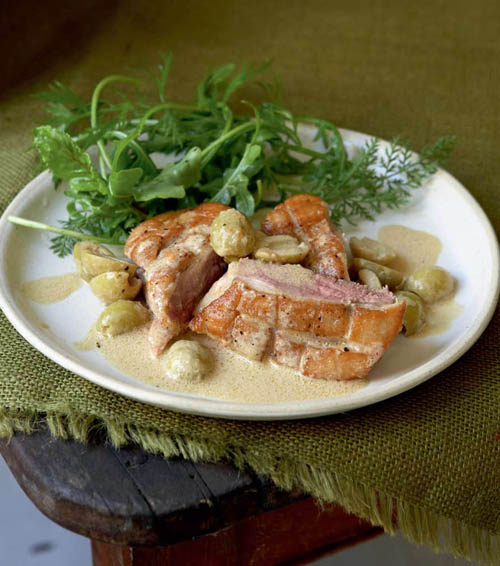
Amarula® liqueur with its strawberry-like aroma warrants a special mention. The fruit used is the berry of the marula tree and these berries are a favourite with elephants in the wild. The berries are also used in home brews in Africa.
- 6 duck breasts
- salt and pepper
- 2 Tbsp vegetable oil
- 1 cup chicken stock
- 2 Tbsp brandy
- ¼ cup Amarula® liqueur
- ½ cup pitted green olives, halved
- ½ cup sour cream
- Pat the duck breasts dry, then score the skin in a criss-cross pattern with a sharp knife. Season the breasts with the salt and pepper.
- Heat the oil in a frying pan and brown the breasts for 5 minutes on each side. Remove from the pan and keep warm.
- Pour off most of the fat from the frying pan, leaving 2 tablespoons of oil. Pour in the chicken stock and boil for 5 minutes. Lower the heat and add the brandy, liqueur and olives. Stir well, then add the sour cream and heat for 1 minute. Season with salt and pepper.
- Slice the duck, arrange on a serving plate and pour the sauce over the slices.
- Serve with Baked Sweet Potatoes Stuffed with Vegetables (see page 113). SERVES 4–6










